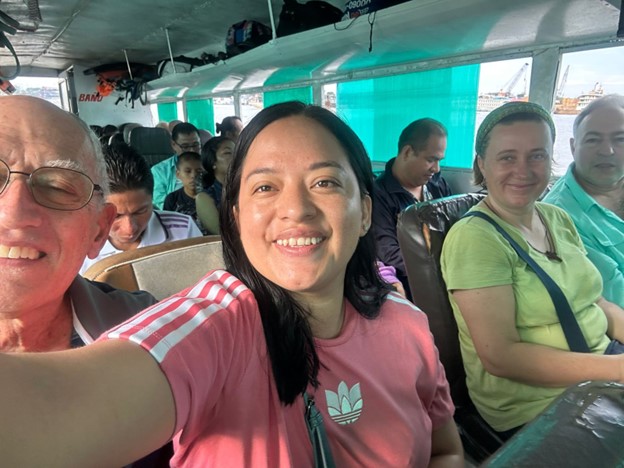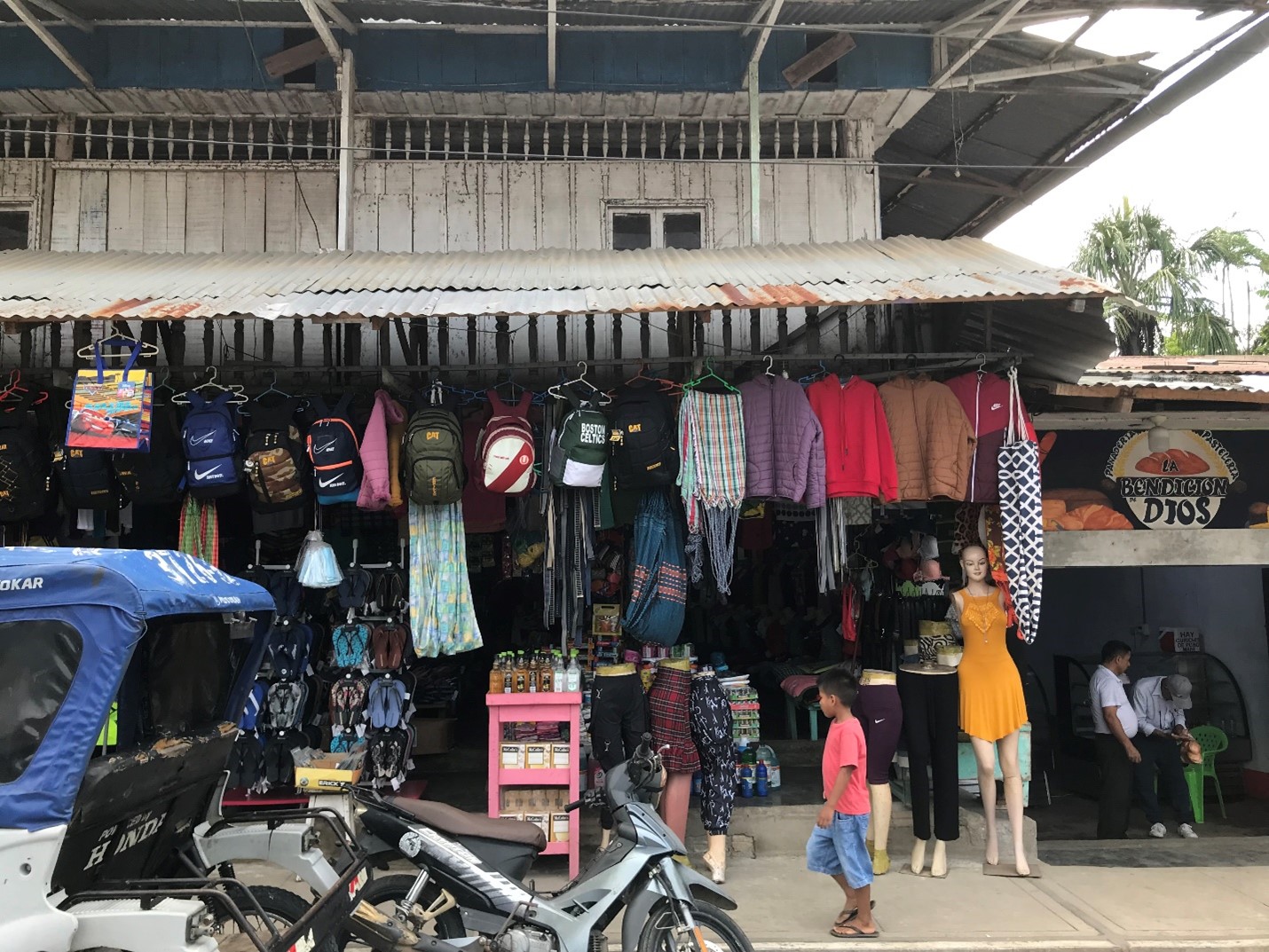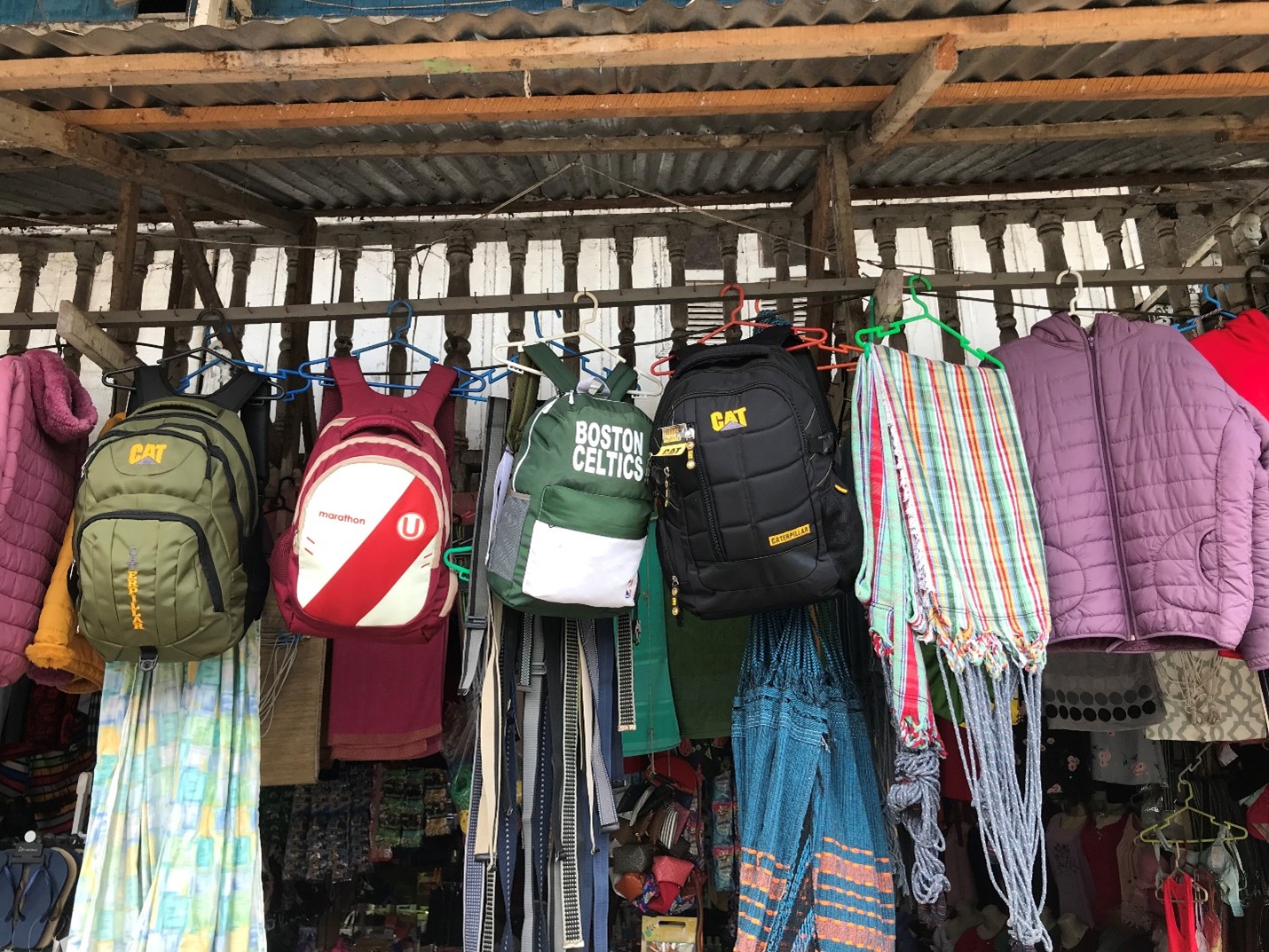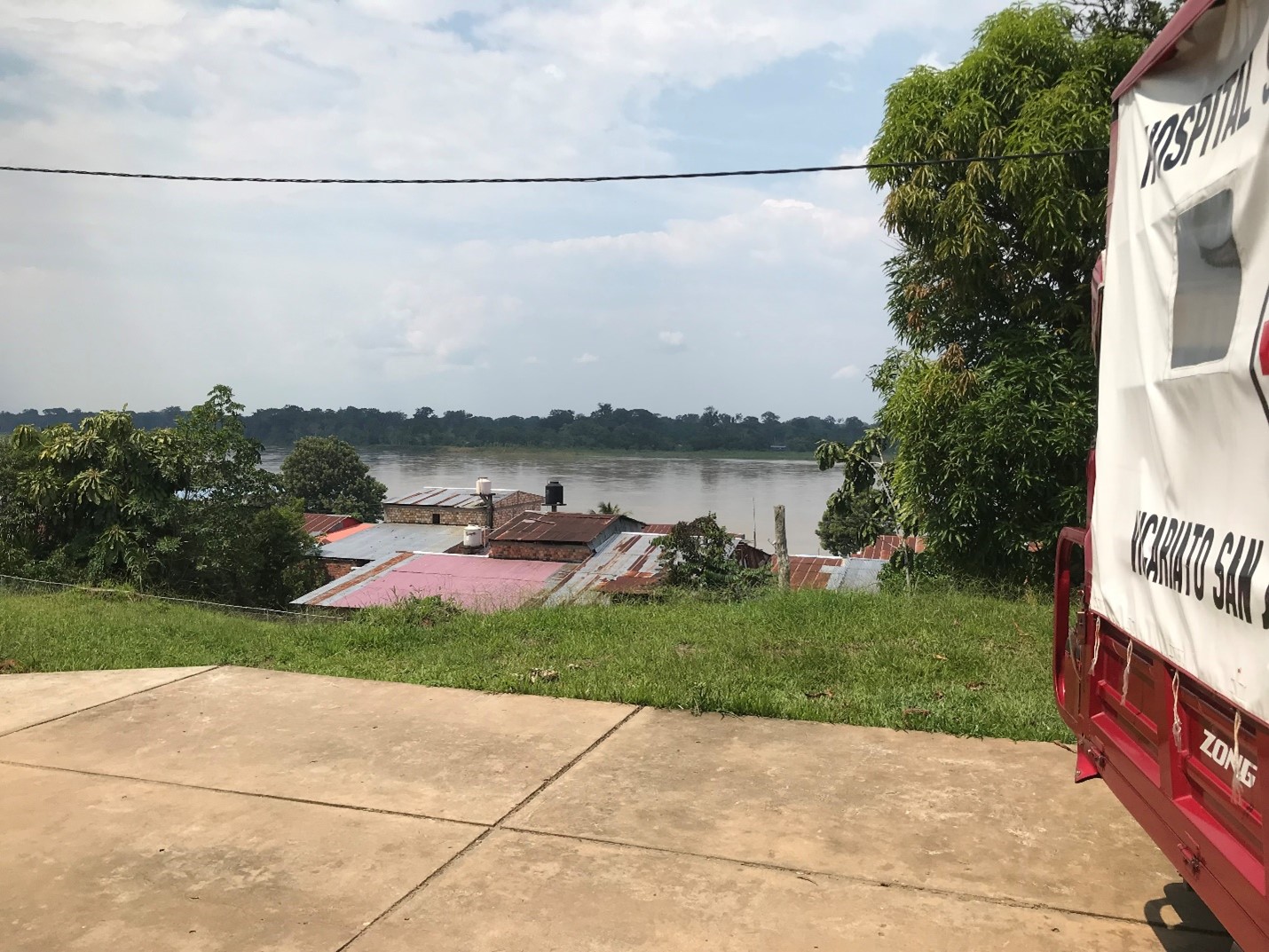Another travel day starts brutally early as the alarm sounds at 5:40 am – I’m sure I am not the only one who hates alarms. Thankfully, packing was brief since we did not take out any equipment for our one-day stay in Iquitos. I had no idea what to expect for the day, other than we were starting off on an Amazon tributary (the Rio Itaya), then 20+ miles up-river on the Amazon, followed by a meandering 100+ miles up-river on the Rio Napo to Santa Clotilde.
Arriving at the docks, we paid local porters to bring our baggage down. We weaved through alleyways and down steps to find ourselves in front of some warehouse-type building with ramps and a partially submerged, wobbly board that took us across in front of our boat. As we waited to board, we were presented with a quiet sunrise over the river.
 The boat operators loaded our luggage on the boat roof. We were met at the dock by Gabriela Filonowicz and Dr. Norberto Aramburu, who were traveling back to Santa Clotilde. Dr. Aramburu is from Spain, but has been working at Santa Clotilde hospital for two years. Three of his old college mates had flown out to meet him and I guess see what life was like, practicing medicine in the jungle. We started off the trip comfortably enough.
The boat operators loaded our luggage on the boat roof. We were met at the dock by Gabriela Filonowicz and Dr. Norberto Aramburu, who were traveling back to Santa Clotilde. Dr. Aramburu is from Spain, but has been working at Santa Clotilde hospital for two years. Three of his old college mates had flown out to meet him and I guess see what life was like, practicing medicine in the jungle. We started off the trip comfortably enough.
We were told this first leg was only about one hour and that we would be stopping at a town called Mazán, where we would disembark, take moto-taxis across a two-mile strip of land, and reboard a different boat for an additional 7 hour journey up the Rio Napo. As seen in this map, the Napo does flow into the Amazon, but the junction is further down-river and would require an extra loop, likely adding a few hours or so to the total travel time.

 On the boat, Brian and Leslie bought fans from an enterprising vendor who came aboard for sales. I sat with Gabriela and listened to a little of her background. She is a Catholic lay missionary from Poland. She started off working in southeastern Africa, and then northern Peru. She has been in mission work for twenty years. In Peru, she started out working with children in Iquitos. If I heard correctly (recall it is a noisy boat and my Spanish is only mediocre at best), she had worked there for nearly fifteen years. Every two years, she goes back to Poland to meet with the Diocesan Bishop to renew her assignment. She told me this has worked out very well, as it provides her the opportunity to request what she needs to help the people. A few years back, the opportunity came up to help run the hospital at Santa Clotilde.
On the boat, Brian and Leslie bought fans from an enterprising vendor who came aboard for sales. I sat with Gabriela and listened to a little of her background. She is a Catholic lay missionary from Poland. She started off working in southeastern Africa, and then northern Peru. She has been in mission work for twenty years. In Peru, she started out working with children in Iquitos. If I heard correctly (recall it is a noisy boat and my Spanish is only mediocre at best), she had worked there for nearly fifteen years. Every two years, she goes back to Poland to meet with the Diocesan Bishop to renew her assignment. She told me this has worked out very well, as it provides her the opportunity to request what she needs to help the people. A few years back, the opportunity came up to help run the hospital at Santa Clotilde.
 To capably administer this job, Gabriela took classes in management. It was evident that she is very bright and has a winsome personality. All of the taxi drivers, porters, and boat drivers know her and show obvious respect. I found it particularly impressive that they found a way to make happen whatever she asks of them. This was very encouraging, because for a project to be successful you need the right partners. You can have amazing technology, a dedicated team, and the best intentions, but without someone in the local region who has the appropriate clout and serves as the project’s champion, it will not succeed. We are very fortunate to have Gabriela. She understands how the project can help people, and she seems committed to making this a success.
To capably administer this job, Gabriela took classes in management. It was evident that she is very bright and has a winsome personality. All of the taxi drivers, porters, and boat drivers know her and show obvious respect. I found it particularly impressive that they found a way to make happen whatever she asks of them. This was very encouraging, because for a project to be successful you need the right partners. You can have amazing technology, a dedicated team, and the best intentions, but without someone in the local region who has the appropriate clout and serves as the project’s champion, it will not succeed. We are very fortunate to have Gabriela. She understands how the project can help people, and she seems committed to making this a success.
We had to disembark at Mazán and as you can see, this entails walking a gangplank. By now, it was very warm and sunny as we waited on the river bank for our luggage to come off the boat roof and load into moto-taxis for the short ride over to the Rio Napo.
While awaiting the next departure, we walked into town where we bought egg sandwiches and water. I am including some pictures to give you a sense of what the market is like. (For all of my Massachusetts die-hard fans) you may notice a backpack with the Boston Celtics’ logo for sale – even here in the Amazon jungle. You can also see a moto-taxi with some chickens hanging in the back.
We boarded the boat last – this was a mistake!
Every seat was taken except for three in the back. The very back seat was isolated and right next to the bathroom. I did not want Leslie to get stuck with this seat, so I offered to take it myself. The first problem became evident as soon as I sat down. The seat started to rock and tip over because it was not anchored to the floor. There was a 5-gallon plastic bucket next to the seat which I used for lateral stability – and then by spreading my legs wide, I kept the seat, for the most part, from tipping over. The next issue became apparent when the boat started to move. It did not have a complete set of windows above the gunwale to protect passengers from water spraying up the side into the passenger compartment. This condition was exaggerated by the back of the boat resting the lowest. To make the situation more comical, a tire tied to the side, used for docking the boat, was slapping back and forth with the waves, causing torrents of water to splash up, drenching my right arm and leg. Eventually, I was able to fix this problem by stuffing a couple of life jackets into the missing window’s opening, thereafter only getting the occasional dousing when a wave was particularly aggressive. The third and final issue was the noise. I was virtually sitting on top of the boat motor. The sound was deafening. This problem is exacerbated by the fact that ever since I had Covid, I suffer from hyperacusis – a lovely condition which results in sounds being amplified in your head. After the first hour, I dug through my bag to find a pair of foam earplugs. This helped, but not enough. Finally, I decided to get out my noise canceling headphones because I was sure to go crazy from the noise and resulting headache.

 By the time we arrived, I thought my feeling queasy was the result of the ride. I’m sure it did not help – but that was not all of it. As we walked up the stairs to the hospital and our living quarters, I knew I was sick, with clear fever symptoms. This is my tenth “mission” type trip and I had never before succumbed to illness. I am very careful, trying to avoid the obvious pitfalls – but apparently, I was not careful enough. Feeling lousy, I did not take very many pictures after landing, the walk up to the base of the clinic, or the long stairs that go up to the boarding house where we were staying. I did capture a picture of the ambulance they use at the hospital. In this case, the patients were our suitcases, sparing us having to carry them up the hill.
By the time we arrived, I thought my feeling queasy was the result of the ride. I’m sure it did not help – but that was not all of it. As we walked up the stairs to the hospital and our living quarters, I knew I was sick, with clear fever symptoms. This is my tenth “mission” type trip and I had never before succumbed to illness. I am very careful, trying to avoid the obvious pitfalls – but apparently, I was not careful enough. Feeling lousy, I did not take very many pictures after landing, the walk up to the base of the clinic, or the long stairs that go up to the boarding house where we were staying. I did capture a picture of the ambulance they use at the hospital. In this case, the patients were our suitcases, sparing us having to carry them up the hill.
When we got to our quarters, I lay down in bed and skipped the afternoon meetings. I just lay there and tried to recuperate. I’d likely picked up some bacterial infection and was now going to experience its power. Ironic how we can be laid low by something so small. The rest of the day was a blur. The little personal fan was my redemption. I don’t know how I would have survived without it. I was given an antibiotic and some Tylenol and eventually became well enough that I could try to eat a few bites.
 This experience reminded me about the value of unexpected kindness and compassion. One of the Sisters, Yanabel, of a religious Order called Las Hijas de San Camilo (the Daughters of Saint Camillus), known by a large red cross that is sewn onto their habits, heard I was ill. She went off to make chicken soup for me and then proceeded to brew up some chamomile tea. She was so kind and sweet, trying to make sure that I was taken care of. She works the dayshift as a nurse, and could easily have said after a full day’s labor, that she was tired and had already done what was required of her. Instead, she showed concern for a stranger she had never met. There are angels in this world. I am sorry that I did not get a picture of her – but I guess my synapses weren’t firing well at the time.
This experience reminded me about the value of unexpected kindness and compassion. One of the Sisters, Yanabel, of a religious Order called Las Hijas de San Camilo (the Daughters of Saint Camillus), known by a large red cross that is sewn onto their habits, heard I was ill. She went off to make chicken soup for me and then proceeded to brew up some chamomile tea. She was so kind and sweet, trying to make sure that I was taken care of. She works the dayshift as a nurse, and could easily have said after a full day’s labor, that she was tired and had already done what was required of her. Instead, she showed concern for a stranger she had never met. There are angels in this world. I am sorry that I did not get a picture of her – but I guess my synapses weren’t firing well at the time.
Again, I am thankful for everyone who is following this journey with me. Look for my next chapter soon.
Below are hyperlinks to the prior blogs on Bringing VSI Imaging to the Amazon of Peru:
BRINGING VSI IMAGING to the AMAZON of PERU (Intro/Chapter 1)
BRINGING VSI IMAGING to the AMAZON of PERU (Chapter 2)
BRINGING VSI IMAGING to the AMAZON of PERU (Chapter 3)
BRINGING VSI IMAGING to the AMAZON of PERU (Chapter 4)
Frank Miele, MSEE , President of Pegasus Lectures, Inc. Frank graduated cum laude from Dartmouth College with a triple major in physics, mathematics, and engineering. While at Dartmouth, he was a Proctor Scholar and received citations for academic excellence in comparative literature, atomic physics and quantum mechanics, and real analysis. Frank was a research and design engineer and project leader, designing ultrasound equipment and electronics for more than ten years at Hewlett Packard Company. As a designer of ultrasound, he has lectured across the country to sonographers, physicians, engineers and students on myriad topics.












